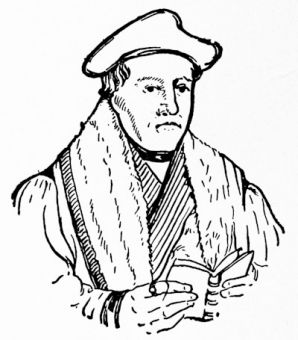"And forasmuch as my hand offended in writing contrary to my heart, therefore my hand shall first be punished."
- Cranmer's words at his execution.

Thomas Cranmer was born in 1489 at Aslacton, Nottinghamshire, where his father was a poor village squire. He received his basic education at home, then entered Jesus College, Cambridge, in 1503. He became a fellow of the college in 1510, but was forced to abdicate that post after he married his first wife, Joan. After her death in childbirth he re-entered the church and became a fellow of the college once more.
Cranmer was an enthusiastic scholar, and he found himself in sympathy with the continental movement toward church reform that emphasized the importance of both the Bible and secular authority over papal authority.
Cranmer may have been content to live out his life of study at Cambridge, but the personal life of King Henry VIII was about to bring this obscure churchman to international prominence. When Henry's divorce proceedings against Katherine of Aragon hit legal snags, chance brought Cranmer to Henry's notice.
When an outbreak of the "sweating sickness" struck Cambridge in the summer of 1529, Cranmer left the town to stay in Waltham, Essex. There he met two of Henry's chief advisors, Edward Fox and Stephen Gardiner, who were impressed by his theological arguments in favour of the king's divorce. They presented Cranmer to the king, who immediately had Cranmer write a theological defence of his position, arguing that Henry's marriage with the widow of his deceased brother was not legal.
Cranmer defended this treatise before theologians at the universities of Oxford and Cambridge, in the process earning the gratitude of Henry and the enmity of Katherine's supporters, including her daughter, Mary. Thereafter Henry employed Cranmer on several embassies abroad, first to the Pope, and later to make surreptitious contact with Protestant leaders in Europe.
In 1532 Cranmer married for the second time, to Margaret, daughter of a Lutheran scholar. Margaret's moment in the public eye was brief, however.
The following year Cranmer was elevated to the Archbishopric of Canterbury, and in keeping with the king's objections to ecclesiastic marriages, he was forced to send his wife into hiding and later to officially banish her. This peculiar state of affairs continued until reforms in the reign of Henry's son Edward VI allowed clergymen to marry, and Cranmer could once more live openly with his wife.
In the meantime, Cranmer supported, at least in public, Henry's numerous marital manoeuvres. In his role as Archbishop of Canterbury, he officially dissolved Henry's marriage with Katherine of Aragon and later helped preside over the trial of Anne Boleyn, the divorce from Anne of Cleves, and Catherine Howard's trial and execution. In these proceedings Cranmer showed his pliability; he seemed unable to deny Henry any whim.
Cranmer seems to have been genuinely opposed to Henry's Dissolution of the Monasteries, though his devotion to the secular authority of his master did not allow much scope for challenging Henry's decisions! Certainly, Cranmer was one of Henry's most valued servants during the Dissolution, and as such, he took a lot of the blame from those opposed to the policy.
During the reign of Henry VIII, Cranmer worked toward his own version of sensible ecclesiastical reform, including a new translation of the Bible in English. But it was his actions during the reign of Edward VI that made Cranmer a truly controversial figure, alternately despised and applauded by English Catholics and Protestants.
In 1549 Cranmer produced The Book of Common Prayer (a second revised version was issued in 1552), which introduced a storm of controversy. Cranmer presented the view that a proper Christian Communion depends more on the heart of the practitioner than the actual bread and wine used in the ceremony. He also encouraged the public reading of the Bible by the entire congregation.
Though to modern ears these views seem sensible, or at least worthy of reasoned consideration, at the time they were nothing short of revolutionary. Cranmer was castigated by Catholics and occasionally by zealous Protestant reformers who claimed he was not revolutionary enough!
Cranmer's brief reform movement was overturned when Mary I came to the throne in 1552. Mary, a firm Catholic, blamed Cranmer for her mother's divorce. She quickly had Cranmer tried and sentenced to death for treason. The sentence was not carried out, though, and Cranmer was tried anew for heresy.
During his trial, Cranmer sensibly recanted his reform views and affirmed the supreme authority of the Pope and the physical presence of Christ in the bread and wine of Communion. He signed an official document renouncing his reformist views.
Despite this recantation, he was convicted of heresy and sentenced to death. Perhaps realizing that his chances of survival were gone, Cranmer faced death with remarkably calm. On March 21, 1556 he was burned at the stake at Oxford.
As the flames rose about him, Cranmer renounced his previous recantation and held out the treacherous right hand that had signed the documents, so that it might be the first consumed by the fire. Cranmer is one of three bishops whose deaths are commemorated by the Martyr's Memorial in Oxford.
His dramatic death notwithstanding, Thomas Cranmer is remembered as one of the prime architects of England's move away from traditional Catholic worship and towards its own form of Anglican religious observance.
Related:
Henry VIII
Edward, Mary, and Elizabeth
Tudor Britain - from 'A History of the British Nation' (1912)
Tudor attractions in Britain (places to see tagged with 'Tudor')
